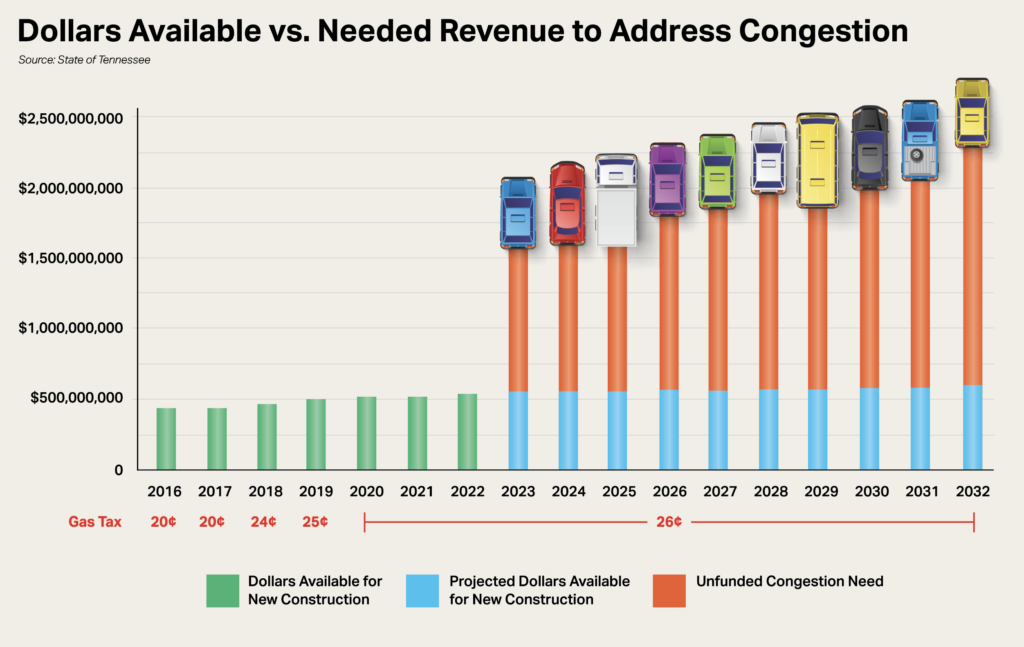A rise in vehicles on Tennessee’s roadways coupled with a flattening of TDOT revenue prompt Gov. Bill Lee’s administration to push transportation legislation
By Dave Ongie
Tennessee’s population has been increasing drastically in the wake of the COVID-19 pandemic, and 2022 was another banner year.
Tennessee grew by 1.2 percent last year, the largest one-year increase since 2007 and the eighth largest single-year spike in the history of the state. While the pandemic accelerated growth across the state, there was plenty of growth before COVID-19. In fact, Tennessee’s population increased around 9 percent over the past decade, and areas like Chattanooga, Murfreesboro and Nashville have grown rapidly as a result.
Murfreesboro is currently growing at a rate of 2.72 percent and its population has grown a whopping 8.64 percent since 2020. Nashville grew at a 1.73 percent clip year-over-year in 2022 while Chattanooga is growing at a nearly 1-percent clip.
Those who live in these rapidly growing areas can attest to the fact that traffic congestion is reaching a critical mass on roads that were never intended to accommodate the volume of vehicles now sharing the roads on a daily basis. State leaders recognize that gridlock on the roadways can potentially be a drag on the economy, and studies commissioned by the state show that new solutions will be required to ensure people and goods can move seamlessly across the state.
With that in mind, Tennessee Governor Bill Lee recently rolled out the Transportation Modernization Act of 2023. The legislation is designed to help the Tennessee Department of Transportation (TDOT) seek public-private partnerships to allow private investment in new urban roadway infrastructure, explore the implementation of Choice Lanes – additional optional lanes designed to decrease congestion in urban areas – and expand the alternative delivery model to save taxpayer dollars and expedite road projects.

“As Tennessee continues to experience tremendous growth, we have an obligation to make strategic transportation investments that prepare our state for continued success – without raising taxes or going into debt,” Tennessee Governor Bill Lee said while unveiling his transportation plan for the state. “Our infrastructure plan will prepare Tennessee communities, both rural and urban, for increased economic advantages and improved mobility in the years ahead. I look forward to partnering with members of the General Assembly to solve transportation challenges.”
Gridlock
When the IMPROVE Act of 2017 was passed, increases in vehicle registration fees and the fuel taxes were meant to help improve public roads. Even with those revenue increases, TDOT finds itself struggling to keep pace as growth is far outpacing roadway capacity investments.
As of now, $26 billion is needed over and above funds collected through the IMPROVE Act to address congestion in both urban and rural areas. The lion’s share of that amount – around $14 billion – is needed to relieve traffic congestion in Nashville, Memphis, Chattanooga and Knoxville. The remaining $12 billion is required to improve traffic flow on rural interstates across the state.
So how bad is the congestion? TDOT studies show commute times in urban areas are expected to increase by 60 percent with travel times between major cities in the state increasing up to an hour.
When you consider TDOT’s conventional funding model, this increased demand could not be coming at a worse time. Motor fuel taxes have long been the backbone of TDOT’s revenue stream. However, the increasing fuel economy of vehicles on the road coupled with the increased prevalence of hybrid and electric vehicles is putting downward pressure on field tax collections. According to TDOT projections, tax collections will remain flat despite the fact vehicle miles traveled are increasing.
TDOT also projects that $1.2 billion will be required annually for construction and maintenance projects capable of moving the needle on current congestion issues. Of that, only $500 million is currently available.

Changing Lanes
Since the administration does not wish to raise gas taxes or take on debt, public-private partnerships are a major cornerstone of the proposed transportation legislation. Private investment will be sought for projects in urban areas, which Lee hopes will allow the state to use current funding for more rural infrastructure projects.
As it stands, Tennessee is the only state in the southeast that does not allow public-private partnerships for the development of roads and bridges. Several states – including Texas, Florida, Georgia, North Carolina and Virginia – have used such partnerships to address pressing transportation needs. Under this model, private-sector partners enter into an agreement with the state department of transportation to design, build, finance, operate and maintain infrastructure projects.
The most popular of these projects as Choice Lanes, which allow motorists to pay in order to take an express lane through congested urban areas in order to arrive at their destination more quickly. While toll roads are not popular due to their involuntary nature, State Senator Rusty Crowe believes Choice Lanes will be embraced by commuters and he noted that Gov. Lee is a strong proponent of these lanes as well.
“For the bigger cities, that will probably be something that’s going to happen,” Crowe told the Business Journal. “At the same time, that would probably be a public-private partnership, so the dollars that are spent on that won’t be state dollars – they’ll be private business dollars. It will be a benefit for us not having to use our tax dollars on that.”
A Faster Route
When it comes to building roads, time is money.
It currently takes TDOT 15 years on average to deliver a project from initial development through construction. Meanwhile, costs continue to rise, and as a result, projects end up costing approximately 40 percent more than what was budgeted initially.
Moving forward, TDOT is looking to use alternative delivery methods in order to speed up projects by allowing steps of the process to take place concurrently. Current laws limit the number of projects that can be delivered through alternative methods, and some expedited models like Progressive Design-Build (PDB) are restricted all together. For that reason, Lee’s legislation intends to expand the alternative delivery model in hopes of expediting projects and saving taxpayer dollars.
Alternative delivery models have already shown some promise in Tennessee. TDOT’s alternative delivery program has demonstrated $22 million in cost savings with nearly 70 percent faster delivery compared to the conventional model.
An example of the promise in alternative delivery methods can be found when you compare two TDOT projects which started at the same time. The first project on I-75 was completed in 945 days using an alternative model at a price of $133 million – just $1 million more than the original contract. The second project on I-124 was completed using the traditional model. It took 1,723 days to complete with an $18 million difference between the original contract ($126 million) and the adjusted contract ($144 million).
The legislation is expected to be considered by the Tennessee General Assembly this session, and TDOT Commissioner Butch Eley is hopeful solutions will be found to help close the expanding gap between the state’s transportation needs and its current budget for road projects.
“Tennessee is facing a critical juncture when it comes to transportation and mobility,” said Commissioner Eley. “Our infrastructure investments will ensure that TDOT has the tools needed to quickly deliver and maintain quality roads so that Tennesseans and commerce can move across our state, all while saving taxpayer dollars.”



